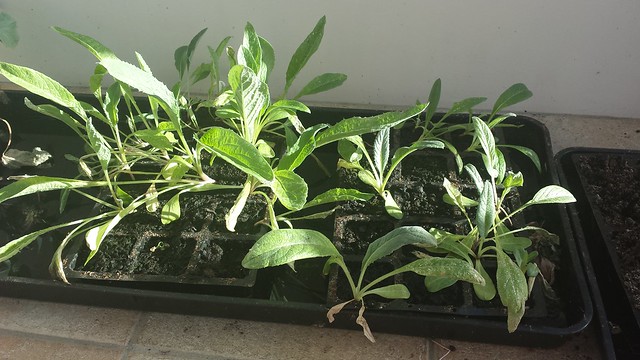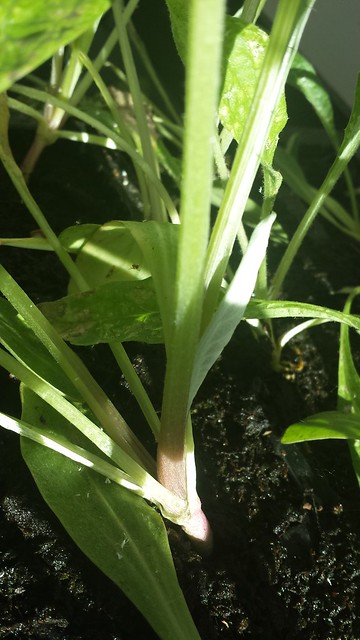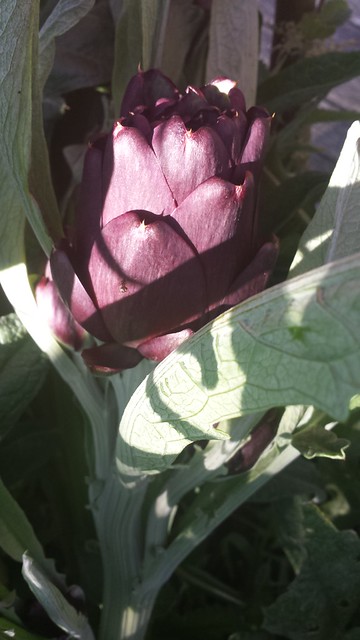|
|
Post by taihaku on Mar 30, 2015 5:07:11 GMT -5
This project's very much at the daydreaming stage at present but, as I've made my first tentative steps in the direction of making it a reality, I thought I'd put a post up, seek some input and use the post as a springboard to actually try and do something. Globe artichokes are a plant I'm a huge fan of for my location. It is hardy enough in our climate to be perennial, either surviving completely unscathed or regrowing from the roots and crops pretty well for me on neglect. It is also highly ornamental, fits nicely in the vaguely mediterranean, vaguely new perennial styled ornamental beds I have around the house and is very popular with pollinating insects when I leave buds uncollected. It's something I want more of and I've had it in mind for a while to grow a few varieties out from seed in a big bed and then select the best and transplant them into more ornamental positions and/or create a couple of artichoke hedges to edge off growing areas from "wild areas" on the property.
On the basis of the good aspects of globe artichokes, I'm similarly enthused about the prospects of growing cardoons which I've never tasted but which will have a lot of the above upsides even if my verdict on their taste and their apparent faff to harvest is not favourable. Selecting my seed varieties of cardoon and artichoke led me to my proposed project.
I've opted to grow violetta precoce which has chunky purple chokes (I currently grow "violet globe" which is fairly similar and which I may involve at some stage in this).
I've also bought seeds for two cardoon varieties: gobbo di nizzia and rouge d'algers. Rouge d'algers is the key to this as it has red blushed stems that I find rather beautiful. Based on the pictures the degree of red seems to be variable so my plan is to grow out a load of these and retain those which show a lot of red. At the same time I'll be looking for the most precocious and purple of the violetta precoce. My goal is then to mix these plants up in planting and grow out seeds to produce at best a red-legged purple artichoke or failing that an improved "redder and purpler" red cardoon strain. In either case the resultant plant would, in my view, be a nice strain for pure ornamental use and edible landscaping (and will surely make my first million). If not I'll just have a load of cardoon and artichoke plants around the place which is also fine.
I'm hoping the red will be apparent in seedlings at quite a young stage in which case I might be able to just grow out violetta precoce seed and identify anything with rouge d'algers influence but at this stage I don't know that (if anyone does I'd be delighted to hear). I'm also not to clear on the viability of cardoon/artichoke crosses and how easy they are to do manually - again if anyone can help me shortcut that research I'd be keen to hear.
So that's the plan. I'll update again in due course.
|
|
|
|
Post by rowan on Mar 30, 2015 5:16:39 GMT -5
Sounds like an interesting project I will be keen for updates.
|
|
|
|
Post by diane on Mar 30, 2015 11:30:17 GMT -5
Another purple one you might like to grow - Violet de Provence
My neighbours are from the South of France and reminisce about a small purple artichoke that they used to eat raw.
I asked them to have their family send seeds, but they never did, so I bought some Violet de Provence seeds from
Baker Creek. I am growing sixty seedlings (despite the packet's promise of only 25 seeds) so soon we should know if
these are the right ones.
|
|
|
|
Post by templeton on Mar 30, 2015 17:26:44 GMT -5
Some good info here - <http://compgenomics.ucdavis.edu/compositae_data.php?name=Cynara+cardunculus>, including pictures of some F1 hybrids.
Good luck.
T
|
|
|
|
Post by taihaku on Mar 31, 2015 4:30:48 GMT -5
Some good info here - <http://compgenomics.ucdavis.edu/compositae_data.php?name=Cynara+cardunculus>, including pictures of some F1 hybrids. Good luck. T Thanks All - T, that link is awesome; so much cool stuff there just in the pictures - really like the look of that wild type "creta 4" cardoon (from an ornamental aspect - harvesting/food usage looks disastrous) and the white flower on that hybrid is interesting also (ornamentally again).The more I look at different forms of this species the more potential I see to breed edible landscaping varieties combining a couple of existing characteristics here or there but perhaps I'm just an optimist. I'm also enthused to grow this species as, here at least, individual plants are quite expensive even as plugs so I think I may be able to rehome on seedlings which don't fit my chosen characteristics as generic cardoon/artichoke seedlings and perhaps partially cover the cost of my seed habit.
Diane - violet de provence was the other purple parent I considered. It was essentially a toss up between the two. Depending upon what the purple 'chokes I grow out look like I may add that into the mix at some point also. I'm looking for a "pointy" choke to fit in with the cardoon as opposed to a fat globe so I'd be very interested in seeing what you end up with. My seeds are also from Baker Creek (I'm delighted to hear you got more than expected).
|
|
|
|
Post by steev on Apr 1, 2015 0:59:13 GMT -5
I've not yet gotten buds from my artichokes, but my cardoons have been productive of rather bitter greens, an acquired taste; their "chokes" are loved deliriously by bees and very tasty, although only the basal plate is edible (and thin, like other thistles). Gophers are very fond of the roots of both, which humans can also eat.
|
|
|
|
Post by ilex on Apr 5, 2015 8:44:29 GMT -5
|
|
|
|
Post by 12540dumont on Apr 5, 2015 20:48:52 GMT -5
Beautiful Ilex. Steev, are you bleaching your cardoon? If you don't they are bitter. (It's in the article). A pain in the butt, but yummy. A few years ago, I gathered every artichoke I could find. Somewhere on this site, you can find the list of all the named types. I could hardly find more than 6 types.
My artichokes also overwinter....unless the gophers get them. I have to make huge gopher baskets out of rabbit wire for artichokes. Mine get bigger every year. I find them very edible, ornamental and able to take a lickin' from the heat.
The Precoce are VERY thorny. Wear gloves when picking them. I will say that at the seedling state I could not tell that the purple chokes were going to be purple. The Precoce are smaller than most of the other red/purples.
|
|
|
|
Post by templeton on Apr 5, 2015 21:19:51 GMT -5
There's paddocks of wild ones outside Melbourne, been there for a hundred years or so. Maybe I should collect some wild seed...
T
|
|
|
|
Post by ilex on Apr 6, 2015 16:48:19 GMT -5
I don't bleach cardoons and they are NOT bitter, at least not my strain until they bolt. It's a strain from seed, from Switzerland I believe. Taste varies between individuals. Right now I have 2 rows of volunteers ready for a taste test. Great vegetable.
My soil is too clayey for local artichokes. They don't produce well and they are just too easy to find to bother.
A cardoon x artichoke cross could be great. Vigor of cardoon, you eat the leaves, and end with quality artichokes. Even if they are lower quality summer artichokes, it would be a nice step forward.
At least you can make cheese from cardoon.
|
|
|
|
Post by taihaku on Apr 26, 2015 6:52:18 GMT -5
At least you can make cheese from cardoon. You can? Tell me more please. In other news, about 50 seeds each of Rouge D'Alger and Violette Precoce went in this morning. Should produce some decent sized plants to overwinter and flower next year all being well. As Diane noted Baker Creek did me proud with packet size considering the "25 seeds" indicative packet size. |
|
|
|
Post by blueadzuki on Apr 26, 2015 22:32:46 GMT -5
At least you can make cheese from cardoon. You can? Tell me more please. I think a more accurate way to put that is you can make cheese with cardoons. There is something in them that can basically be used as a vegetable analog to rennet (the enzyme used to curdle the milk) It's most prevalent in cheeses from parts of Spain and Portugal, but has become commoner as cheesemakers try to court the vegetarian market (natural rennet is an animal product, so it's out, and some vegetarians also won't accept cheese made with microbial rennet, as it is made from modified microbes) |
|
|
|
Post by taihaku on Jun 8, 2015 13:36:55 GMT -5
A quick card-ichoke update... The seedlings, Cardoon Rouge D'Algiers on left, Artichoke Violetta precoce on right.  Bit leggy as they've been shaded too much. the stem on the best Rouge D'Algiers showing a red blush.  I'd eventually like to get a nice blush on a plant that produces something a bit like this in due course. One of my "purple globes"  |
|
|
|
Post by mskrieger on Jul 2, 2015 14:28:33 GMT -5
Them's some good-looking cardoon seedlings. If you create a red-legged cardoon/artichoke I'd love to try it out here. Cardoons overwintered for me this year under heavy snow cover, but only the ones I didn't harvest. Anyone else have that problem? I think the heavy leaves insulate the growing point on the root, maybe?
|
|
|
|
Post by taihaku on Jul 10, 2015 4:23:58 GMT -5
Them's some good-looking cardoon seedlings. If you create a red-legged cardoon/artichoke I'd love to try it out here. Cardoons overwintered for me this year under heavy snow cover, but only the ones I didn't harvest. Anyone else have that problem? I think the heavy leaves insulate the growing point on the root, maybe?
they're not so good lucking any more! Currently battling powdery mildew. The artichokes are really suffering, the cardoons seem to be fighting it off slowly but surely.
|
|




